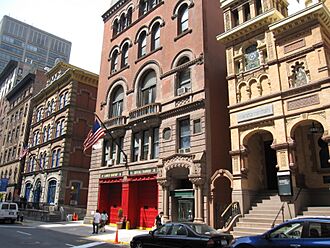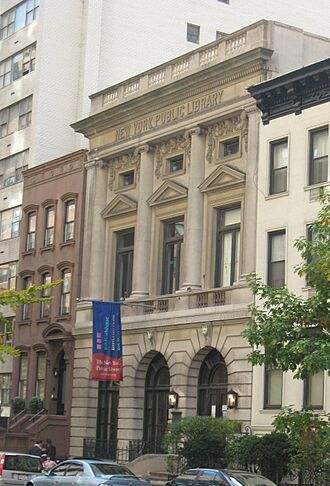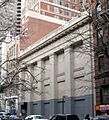Upper East Side facts for kids
Quick facts for kids
Upper East Side
|
|
|---|---|

East 69th Street between Park and Madison Avenues in the Upper East Side Historic District
|
|
| Nickname(s):
UES
|
|
| Country | |
| State | |
| City | New York City |
| Borough | Manhattan |
| Community District | Manhattan 8 |
| Area | |
| • Total | 4.6 km2 (1.76 sq mi) |
| Population
(2020)
|
|
| • Total | 183,986 |
| • Density | 40,360/km2 (104,540/sq mi) |
| Ethnicity | |
| • White | 79.0% |
| • Asian | 8.6% |
| • Hispanic | 7.1% |
| • Black | 3.2% |
| • Others | 2.2% |
| Economics | |
| • Median income | 1,492 |
| Time zone | UTC−05:00 (Eastern) |
| • Summer (DST) | UTC−04:00 (EDT) |
| ZIP Codes |
10021, 10028, 10065, 10075, 10128
|
| Area code | 212, 332, 646, and 917 |
The Upper East Side, also called UES, is a famous neighborhood in Manhattan, New York City. It is located between 96th Street to the north and 59th Street to the south. To the east is the East River, and to the west are Central Park and Fifth Avenue.
This area includes smaller neighborhoods like Lenox Hill, Carnegie Hill, and Yorkville. For a long time, the Upper East Side has been known as one of New York City's wealthiest neighborhoods. It was even called the "Silk Stocking District" once.
The Upper East Side is part of Manhattan Community District 8. Its main ZIP Codes are 10021, 10028, 10065, 10075, and 10128. The New York City Police Department's 19th Precinct patrols the area.
Contents
Geography of the Upper East Side
Neighborhood borders in New York City are not officially set. However, most people agree on the main boundaries. The Upper East Side is generally from 59th Street in the south to 96th Street in the north. It stretches from Fifth Avenue in the west to the East River in the east. Some guides even extend the northern border to 106th Street near Fifth Avenue.
Main Streets and Avenues
The main north-south streets (avenues) in the area are Fifth, Madison, Park, Lexington, Third, Second, First, York, and East End Avenues. East End Avenue runs from East 79th Street to East 90th Street. The major east-west streets are 59th Street, 72nd Street, 79th Street, 86th Street, and 96th Street.
Historic District
The Upper East Side Historic District is one of New York City’s largest historic areas. It covers streets from 59th to 78th Streets along Fifth Avenue. It also reaches up to 3rd Avenue in some spots. After the American Civil War, this area changed a lot. It went from a run-down place to a busy neighborhood for middle-class families. By the early 1900s, it became known for its grand mansions and large townhouses. Later, many of these big homes were replaced by fancy apartment buildings.
History of the Upper East Side
How the Area Developed
Before Europeans arrived, the Lenape people used this area for fishing camps. They kept the forests open by doing controlled burns. In the 1800s, the Upper East Side was mostly farmland and gardens. The Boston Post Road and the New York and Harlem Railroad ran through it. The railroad had a station at 86th Street, which became the center of German Yorkville.
Wealthy families started building large homes here. One famous house was Gracie Mansion, which overlooked the East River. Many farms were divided into smaller lots for houses. James Lenox created blocks of house lots in the 1870s. He also built the Lenox Library and gave land for the Presbyterian Hospital.
Famous Families Move In
At first, people avoided the smoky railroad tracks on Fourth Avenue (now Park Avenue). Instead, they built beautiful mansions on Fifth Avenue, facing Central Park. Rich families like the Rockefellers, Roosevelts, Kennedys, and Whitneys moved here. Famous business leaders like Andrew Carnegie and Henry Clay Frick also built homes in the area.
Over time, some of these grand private homes were replaced by large apartment buildings. The first apartment building on upper Fifth Avenue was 907 Fifth Avenue, built in 1916.
Transportation Changes
The Third Avenue El (elevated train) opened in 1878. The Second Avenue El opened in 1879. These trains helped middle-class people travel easily to the city center.
Gracie Mansion, the last remaining old villa by the East River, became the home of New York's mayor in 1942. The East River Drive was built along the river. It was later renamed FDR Drive after Franklin Delano Roosevelt.
When the elevated railways on Third and Second Avenues were taken down, it opened up space for new high-rise apartment buildings in the 1950s. However, it also meant the IRT Lexington Avenue Line was the only subway line left. The building of the Second Avenue Subway has made homes in the Upper East Side even more valuable.
People and Community
The Upper East Side is a very populated area. Most residents are adults. Many people here have a college education or higher. The median household income is quite high.
The neighborhood is known for having a lot of wealth. It has some of the highest property prices in the United States. There are a few public housing projects for lower-income families near 96th Street. These are the Holmes Towers and Isaacs Houses. This area borders East Harlem, which has many public housing developments.
Landmarks and Culture
Museums
The Upper East Side is home to some of the world's most famous museums. The museums along Fifth Avenue, next to Central Park, are called "Museum Mile". This area was once known as "Millionaire's Row".
Here are some of the cultural places you can find:
- 92nd Street Y
- Asia Society
- Cooper–Hewitt, National Design Museum (in the Andrew Carnegie Mansion)
- Frick Collection (in the Henry Clay Frick House)
- Goethe-Institut, New York
- Solomon R. Guggenheim Museum
- Jewish Museum of New York
- Metropolitan Museum of Art
- El Museo del Barrio
- Museum of the City of New York
- National Academy of Design
- Neue Galerie
- Park Avenue Armory
- Society of Illustrators
Art Galleries
You can also find several art galleries here, such as:
- Acquavella Galleries
- Kraushaar Galleries
- Katharina Rich Perlow Gallery
- Salon 94
- Anita Shapolsky Gallery
Hotels
Some well-known hotels in the Upper East Side include:
- Carlyle Hotel
- The Mark Hotel
- The Pierre
- The Lowell Hotel
- Plaza Athénée, New York
- The Sherry-Netherland
Places of Worship
The neighborhood has many different churches and synagogues:

- Archdiocesan Cathedral of the Holy Trinity (Greek Orthodox)
- Brick Presbyterian Church
- Central Presbyterian Church
- Congregation Kehilath Jeshurun (Modern Orthodox synagogue)
- Fifth Avenue Synagogue (Orthodox synagogue)
- St. Ignatius Loyola (Catholic Church)
- Islamic Cultural Center of New York (mosque)
- Temple Emanu-El (Reform synagogue)
Diplomatic Missions
Many countries have their consulates or missions to the United Nations in the Upper East Side. They are often located in beautiful old mansions.
- The Consulate-General of Austria is at 31 East 69th Street.
- The Consulate-General of France is at 934 Fifth Avenue.
- The Consulate-General of Greece is at 69 East 79th Street.
- The Consulate-General of Italy is at 690 Park Avenue.
- The Consulate-General of India is at 3 East 64th Street.
- The Consulate-General of Indonesia is at 5 East 68th Street.
- The Consulate-General of Russia is at 9 East 91st Street.
Fire Safety
The New York City Fire Department (FDNY) has several fire stations in the Upper East Side:
- Engine Company 39/Ladder Company 16 – 157 East 67th Street
- Engine Company 44 – 221 East 75th Street
- Engine Company 22/Ladder Company 13/Battalion 10 – 159 East 85th Street
Post Offices and ZIP Codes
The Upper East Side uses five main ZIP Codes: 10065, 10021, 10075, 10028, and 10128. There is also a special ZIP Code, 10162, for 500 East 77th Street. The United States Postal Service has four post offices in the area:
- Cherokee Station – 1483 York Avenue
- Gracie Station – 229 East 85th Street
- Lenox Hill Station – 221 East 70th Street
- Yorkville Station – 1617 Third Avenue
Education
The Upper East Side has many residents who have gone to college. Most adults (83%) have a college degree or higher. This is much higher than the average for New York City. Students in the Upper East Side also do very well in school. For example, 91% of high school students graduate on time.
Schools in the Upper East Side
Public Schools
The New York City Department of Education runs the public schools.
Public Lower and Middle Schools
- PS 6 – Lillie Devereux Blake School
- PS 77 – The Lower Lab School
- PS 158 – Bayard Taylor
- PS 183 – Robert Louis Stevenson School
- PS 267 – East Side Elementary
- PS 290 – The New School of Manhattan
- MS 114 – East Side Middle School
- JHS 167 – Senator Robert F. Wagner Middle School
Public High Schools
- Talent Unlimited High School
- Eleanor Roosevelt High School
- Urban Academy Laboratory High School
Other Schools
- Hunter College High School
Private Schools
Coeducational Schools
- Birch Wathen Lenox School
- Dalton School
- Loyola School
- Lycée Français de New York
- La Scuola d'Italia Guglielmo Marconi
- Ramaz School
- Trevor Day School
Girls' Schools
- Brearley School
- Chapin School
- Convent of the Sacred Heart
- Marymount School
- Nightingale-Bamford School
- Spence School
Boys' Schools
- Allen-Stevenson School
- The Browning School
- The Buckley School
- Regis High School
- St. Bernard's School
- St. David's School
Colleges and Universities
The Upper East Side also has several colleges and universities:
- Hunter College
- Marymount Manhattan College
- Icahn School of Medicine at Mount Sinai
- New York Medical College
- New York School of Interior Design
- Rockefeller University
- Weill Cornell Medical College
Libraries
The New York Public Library (NYPL) has four branches in the Upper East Side:
- The 67th Street branch at 328 East 67th Street.
- The Yorkville branch at 222 East 79th Street.
- The Webster branch at 1465 York Avenue.
- The 96th Street branch at 112 East 96th Street.
Transportation
The Upper East Side has two subway lines. The IRT Lexington Avenue Line (trains 4, 5, 6) runs under Lexington Avenue. The Second Avenue Subway (train Q) runs under Second Avenue.
The Second Avenue Subway helps reduce crowding on the Lexington Avenue Line. The first part of this line opened on January 1, 2017. It has three stations in the Upper East Side: 96th Street, 86th Street, and 72nd Street. More parts of the line are planned for the future.
There are also many MTA Regional Bus Operations routes that serve the area. These include the M1, M2, M3, M4, M15, M31, M98, M101, M102, M103, M66, M72, M79, M86, and M96.
Media and Popular Culture
News
Several news groups focus on the Upper East Side:
- Our Town
- Upper East Site
- Patch UES
In Popular Culture
The Upper East Side has been a setting for many movies, TV shows, and books.
Films
- Breakfast at Tiffany's (1961)
- Kramer vs. Kramer (1979)
- Manhattan (1979)
- The Muppets Take Manhattan (1984)
- Ghostbusters II (1989)
- The Bonfire of the Vanities (1990)
- Harriet the Spy (1996)
- The Thomas Crown Affair (1999)
- American Psycho (2000)
- The Nanny Diaries (2007)
- The Devil Wears Prada (2007)
- Sex and the City (2008)
- Blue Jasmine (2013)
Television Shows
- I Love Lucy (1951–1957)
- The Jeffersons (1975–1985)
- The Nanny (1993–1999)
- Will & Grace (1998–2006)
- Sex and the City (1998–2004)
- Gossip Girl (2007–2012)
- The Real Housewives of New York City (2008–present)
- White Collar (2009–2014)
- Succession (2018–2023)
- And Just Like That (2021–present)
Books
- American Psycho by Bret Easton Ellis
- Blue Bloods series by Melissa de la Cruz
- Breakfast at Tiffany's by Truman Capote
- Gossip Girl series by Cecily von Ziegesar
- Harriet the Spy by Louise Fitzhugh
- My Year of Rest and Relaxation by Ottessa Moshfegh
- Sex and the City by Candace Bushnell
- The Bonfire of the Vanities by Tom Wolfe
- The Catcher in the Rye by J. D. Salinger
- The Devil Wears Prada by Lauren Weisberger
- The Nanny Diaries by Nicola Kraus and Emma McLaughlin
- The Princess Diaries by Meg Cabot
Fictional Places and Characters
- The X-Men's fictional Hellfire Club mansion and the Avengers Mansion are said to be in the Upper East Side.
- Don Draper from Mad Men owned an apartment here.
- Constance Billard School for Girls and St. Jude's School for Boys in Gossip Girl.
- Percy Jackson, the main character from Rick Riordan's books, lives in the Upper East Side.
Notable People
Many wealthy and influential people have lived in the Upper East Side over the years.
Notable Residential Buildings
Some famous residential buildings in the area include:
- 834 Fifth Avenue
- 927 Fifth Avenue
- 930 Fifth Avenue
- 960 Fifth Avenue
- 1040 Fifth Avenue
- 502 Park Avenue
- 520 Park Avenue
- 550 Park Avenue
- 740 Park Avenue
- 778 Park Avenue
- 225 East 86th Street
- 343 East 74th Street
- 20 East End Avenue
- Casa 74
- 1342 Lexington Avenue, where Andy Warhol lived from 1960 to 1972.
Images for kids
-
East 69th Street between Park and Madison Avenues, in the Upper East Side Historic District
-
Gracie Mansion, last of the East River villas
-
45 East 66th Street, a designated New York City landmark, as seen across Madison Avenue
See also
 In Spanish: Upper East Side para niños
In Spanish: Upper East Side para niños










